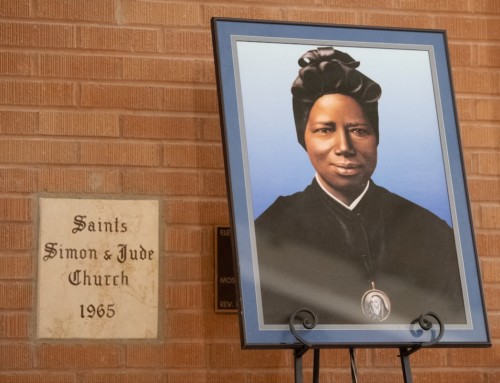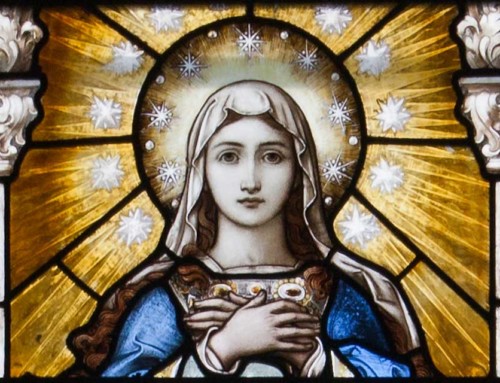Following is the prepared text from Bishop Thomas J. Olmsted’s homily on Good Friday, March 25, 2016:
“Behold the wood of the Cross, on which hung the salvation of the world. Come, let us adore.”
It was the instrument of torture that the Roman Empire used to frighten its enemies, the device of execution on which criminals and enemies of Rome were killed.
It became the altar used by Jesus to establish the Kingdom of God. It became and is the fountain from which the riches of God’s mercy flow. It reveals the love beyond all measure that God has for you and me and every human person. No one has greater love than this, to lay down one’s life for one’s friends (John 13:15).
To reveal the depths of His love for us, Jesus transformed the most horrifying instrument of torture into the perfect instrument of His mercy. He did this by using His freedom to love. At every moment of His suffering and death on the Cross, Jesus acted freely. He embraced His suffering, without compulsion by anyone or anything. He offered to His Father, from the Cross, the gift of redeeming the world.
Only because He acted in complete freedom could His actions be authentic love. That is why He said (Jn 10:18), “No one takes my life from me, but I lay it down on my own. I have power to lay it down, and power to take it up again.”
Throughout His Passion, Jesus was in control, not the Romans, not the Sanhedrin, not Herod or Pontius Pilate, not the crowd. The freedom of Jesus is displayed constantly in the Passion account according to St. John.
Notice, for example, how the arrest of Jesus took place. When Judas Iscariot arrived at the Garden of Gethsemane, accompanied by soldiers and guards, Jesus was in charge, not Judas, not the soldiers. Rather than being caught by surprise as Judas intended, “Jesus knowing everything that was going to happen to Him, went out and said to them, ‘Whom are you looking for’?” When they said, “Jesus the Nazorean,” He answered “I AM,” using the divine name revealed by God to Moses.
Even though Judas and the others came to arrest Jesus, they were overwhelmed by His awesome divine presence; so much so that “they turned away and fell to the ground.” Even His enemies were forced to pay homage to Him.
Later on, St. Paul wrote to the Philippians (Phil 2:10), “At the name of Jesus every knee should bend, of those in heaven and on earth and under the earth.” That is what Judas and the soldiers were compelled to do as Jesus freely took charge of His own arrest by them, and went of his own free will to the trial and execution.
Later on, while Jesus was being questioned by Pontius Pilate, even though Pilate had the political power to put Him to death, it was evident that again Jesus was in charge, not Pilate. Pilate, by talking with Jesus, came to know that He was innocent, and Pilate wanted to release Him, but he was not free from fear; he did not have the courage to do what justice required. Thus, reluctantly, he handed Jesus over to the Jews to be put to death, doing the opposite of what his heart and mind told him to do. Nonetheless, what took place on Calvary was precisely what Jesus desired to happen. For this reason, He came into the world: to redeem the world by freely dying on the Cross, thereby transforming an instrument of torture into a Tree of Life, a fountain of mercy for the fallen human race.
While in the custody of Pilate, too, the soldiers put a crown of thorns on Jesus to mock Him; but ironically, Jesus deserved to wear a crown; He truly is the King, the King of all kings, who’s Kingdom has no end.
The Catechism says of the Cross (#609), “In suffering and death His humanity became the free and perfect instrument of His divine love, which desires the salvation of men.”
Jesus acted in complete freedom at every moment of His Passion. As Pope Emeritus Benedict XVI said: “Even in His Death on the Cross, Jesus remains the Son, who is one with God the Father. When we look upon His face disfigured by beating, weariness, and inner suffering, we see the face of the Father. Indeed, it is precisely in this moment that God’s glory, His surpassing splendor, in some way becomes visible on the face of Jesus. In this poor, suffering man whom Pilate, in the hope of eliciting compassion, showed to the Jews with the words ‘Behold the man!’, we see revealed the true greatness of God, that mysterious grandeur beyond all our imagining.”
The greatness of God stands in stark contrast to the greatness this world admires. It has nothing to do with military might or political clout. “No one has greater love than this, to lay down one’s life for one’s friends (John 13:15).”
Jesus free and glorious outpouring of love for His Father is so great that it reveals the worth of every human person. Our worth and dignity come from being made in the image and likeness of God.
Speaking of this mystery, nearly 800 years ago, St. Anthony of Padua said, “Christ, who is your life, hangs before you, so that you can gaze upon the Cross as if in a mirror…If you look upon Him, you will be able to see the greatness of your dignity and worth…Nowhere else can we better recognize our own value, than by looking into the mirror of the Cross” (Sermones…III, pp. 213f).
What does this mean for you and me? If anyone struggles with the slavery of a vice or addiction, the Cross is the place to find freedom. If anyone doubts God’s love, or is tempted to question whether life is worth living, gaze with faith upon our Crucified Lord. Let Jesus be the Lord and King of your heart. Give Him permission to be in charge when you are afraid, to be your protector when you are battling temptation. The death of Jesus became life for us. His shame became our glory.
St. John describes the grandeur of Jesus’ Cross in this way (Jn 3:16), “God so loved the world that He gave His only Son, so that everyone who believes in Him might not perish but might have eternal life”




